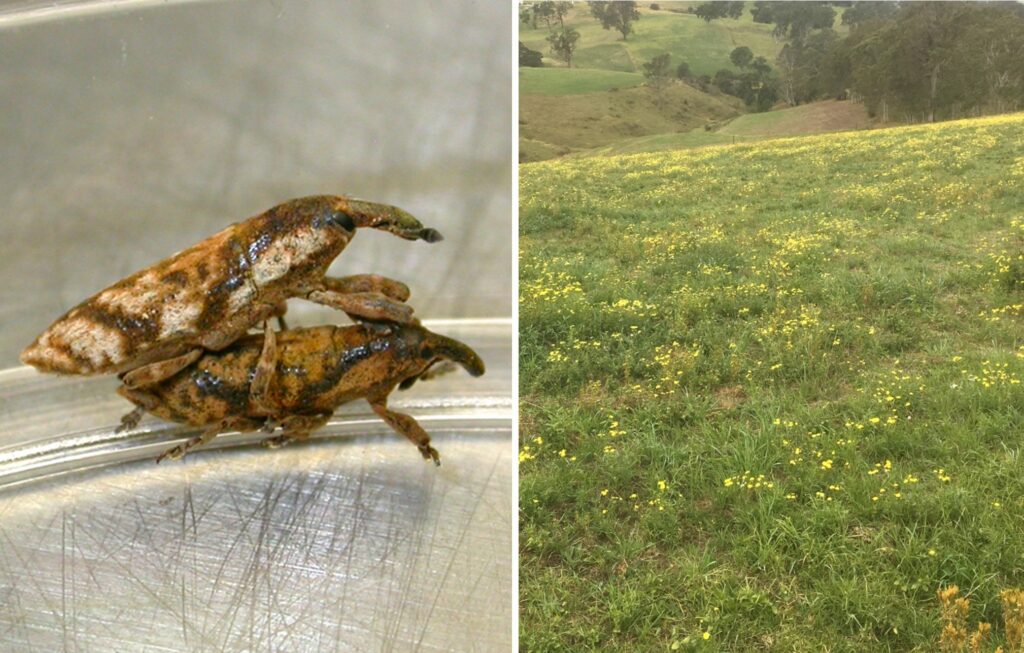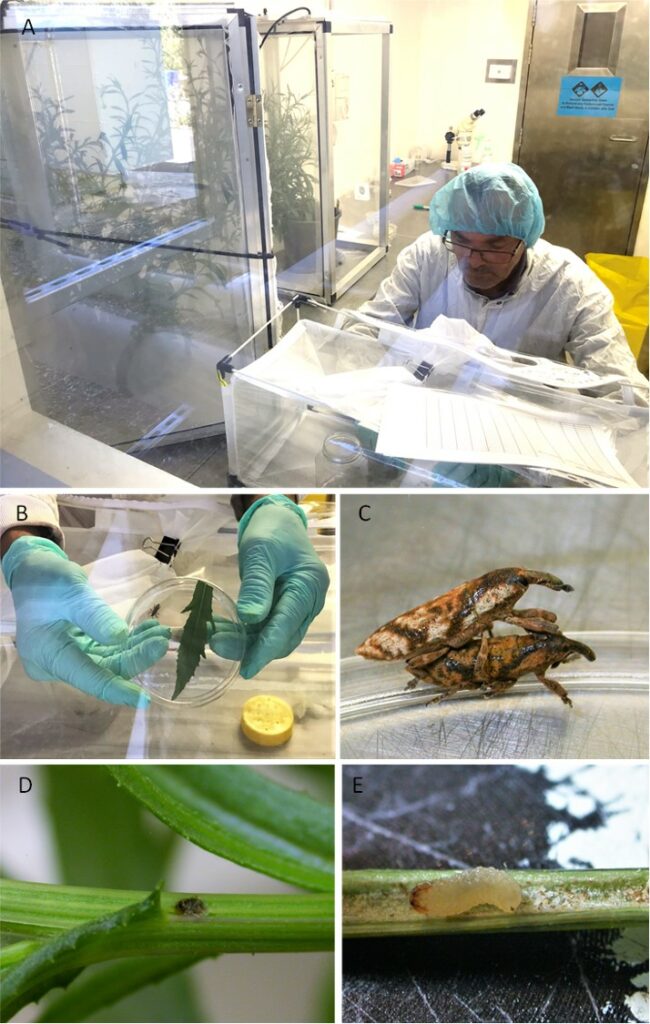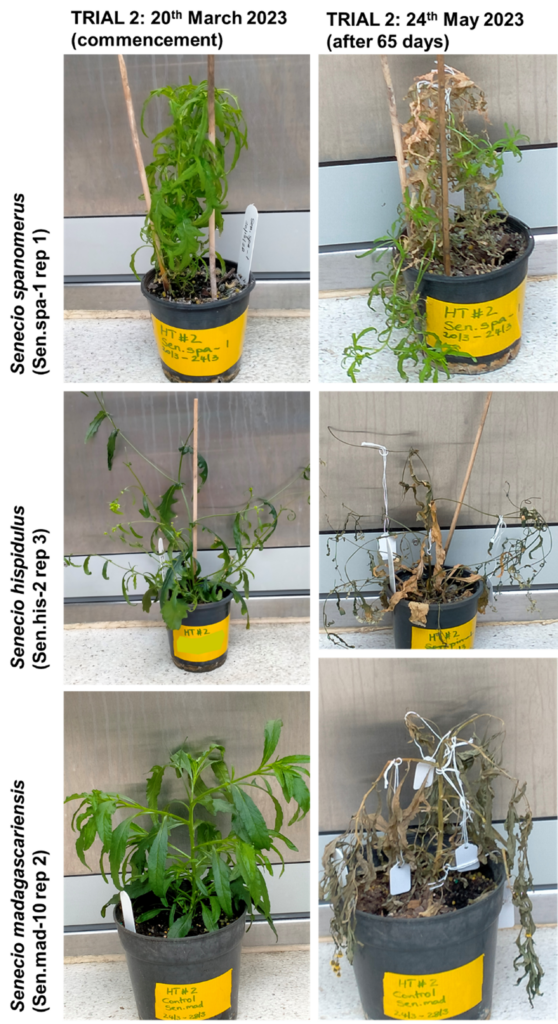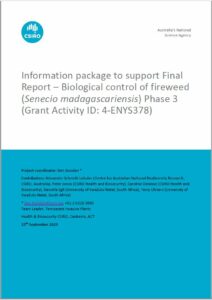Current research (2020-ongoing)
UPDATE DECEMBER 2023
Over the past five months, the CSIRO has continued to undertake no-choice host-specificity tests (altogether for 13 native plant species within the same genus as fireweed, Senecio, and therefore relatively closely related to the weed). We have also undertaken continuation trials and multi-choice host-specificity tests. This work has been undertaken in the CSIRO biological containment facilities (quarantine, based at the Black Mountain Laboratories in Canberra) and by our international collaborators at the University of KwaZulu-Natal (UKZN) in South Africa. This extended work has given us a much clearer understanding of the potential risks posed by the weevil to Australian native plant species.
Some of the key finding that have been considered when assessing the ongoing prospects of research on the weevil include:
- A dedicated plant-growth experiment revealed that the weevil can significantly reduce fireweed seed production at high larval densities but has negligible effects on the growth of fireweed.
- No-choice tests: Of the 13 native plant species deployed in the no-choice tests, the weevil oviposited on 12 species. Larvae developed and caused stem damage to 10 of these species, resulting in plant death in many cases. Larvae could be successfully reared to emergence of F1 adults (offspring) on five of these native plant species. In some cases, native plant species suffered a higher proportion of stem damage due to larval feeding compared to the fireweed plants.
- Continuation trials: We retained the adult F1 weevils on the same non-target plant species that they had developed on, to test if they could reach maturity and reproduce for a second generation on those same native species. Indeed, the F1 weevils reached reproductive maturity and oviposited on two non-target plant species (S. hispidulus, S. brigalowensis), with the larvae causing significant stem damage. However, the larvae did not develop through to emergence of adults and the weevils died after 102 days.
- Multi-choice trials: We exposed non-target native plant species to the weevils in the presence of a fireweed plant. Unfortunately, even with a healthy fireweed plant available, the weevils readily oviposited on the non-target plant species at a similar level to fireweed (mean number of eggs laid +/- SD on non-target plant: 5.5 +/- 3.11; mean number of eggs laid +/- SD on fireweed plant: 8.25 +/- 5.91).
The CSIRO has considered the prospects of gaining regulatory approval to release the weevil into the Australian environment, based on the risk analysis framework deployed the Australian Government Department of Agriculture, Fisheries and Forestry (DAFF) for candidate weed biocontrol agents. The risk analysis considers the “likelihood of off-target effects” and “consequences of off-target effects”. The potential benefits of a biocontrol agent through its damage to the target weed are not considered when assessing the likelihood of off-target effects. A recommendation to permit the release of a candidate biocontrol agent into the Australian environment may be considered if the combined off-target risk estimate is either “Negligible” or “Very Low”.
Based on data collected to date, the CSIRO advises that the weevil would not likely be granted approval for release, as the likelihood of off-target effects is high, and several plant species in the multi-choice tests suffered significant larval damage. It is important to note, however, that no formal recommendation for release or otherwise has been provided by DAFF, as the CSIRO has not submitted its host-specificity data to the regulators for risk analysis.
The CSIRO has sought advice from several weed biocontrol experts across Australia on these data, including senior research entomologists at the CSIRO (Dr Michelle Rafter, Dr Kumaran Nagalingam), the Research Director of the CSIRO’s Biosecurity Program (Dr Raghu Sathyamurthy), and the weed biocontrol research unit at NSW Department of Primary Industries (NSW DPI). All experts have advised that the weevil would likely not be granted approval for release into the Australian environment at this stage, based on results obtained thus far.
For the reasons listed above, host-specificity testing for the weevil in the CSIRO containment facilities will cease and an application for its release will not be submitted to DAFF for formal risk assessment at this stage. However, testing is ongoing at the UKZN laboratories in South Africa, which will continue to yield data on the host-specificity of the weevil to non-target plant species.
Going forward, further multi-choice testing may be warranted, given that multi-choice tests have only been undertaken for four native Senecio species thus far. At present, the CSIRO and other leading weed biocontrol research groups (e.g., at NSW DPI) cannot recommence testing without further investment. However, even with further investment, the prospects for release of the weevil into the Australian environment are very low.
The Australian Government recently announced that it is investing in a national weed biocontrol prioritisation program (https://www.agriculture.gov.au/about/news/weed-biocontrol). There may be an opportunity in to critically evaluate the ongoing feasibility of fireweed biocontrol, including for the weevil and the other candidate biocontrol agents (e.g., the moth Metamesia elegans), thorough this prioritisation program.
UPDATE SEPTEMBER 2023
Objectives
Previous research identified a second candidate biocontrol agent on fireweed in South Africa: a stem-boring weevil called Gasteroclisus tricostalis. This weevil attacks the stems of fireweed and may results in stem collapse, stunted plant growth and a reduction in seed output.
Commencing in 2020 (research ongoing), the CSIRO commenced investigating the host-specificity of the weevil and its safety for native Australian plant species within the genus Senecio. This consisted of host-specificity testing undertaken in South Africa and Australia.

Left: Male and female Gasteroclisus tricostalis, right: fireweed infestation at Brogo, NSW
Establishment of a weevil colony in Australia
Multiple populations of the weevil were sent to Australia from South African via post. Upon receipt, weevils were confined to cages containing healthy and reproductively mature fireweed plants (Bega Valley accession) and monitored every couple of days for adult feeding on fireweed foliage, male and female pairing, and oviposition. Adults that paired up for mating were then moved to separate cages containing fresh fireweed plants. Each oviposition hole was individually tagged and monitored over time. Altogether, the weevils laid > 300 eggs (as of 2nd March 2023).
In January 2023, the first F1 adult (i.e., offspring of the field-collected weevils) emerged at 68 days after first exposure to the fireweed plant. Thereafter, 148 F1 adults have been produced (as of 2nd March 2023). The average (± standard deviation) number of days from oviposition to emergence of F1 adults was 77 (± 7). Commencing on 20th January 2023, the F1 adults were observed to have begun ovipositing on fireweed plants. Altogether, between 20th January and 30th March 2023, the cohort of F1 adults laid 821 eggs.
As such, a healthy weevil culture has now become well-established within the Australian quarantine facility, with a sustained pipeline of oviposition leading to emergence of healthy adult weevils across multiple generations.

Stages in rearing Gasteroclisus tricostalis in quarantine within the CSIRO Black Mountain laboratories, Canberra: (a-b) receipt of first consignment in March 2021, (c) adult weevils copulating, (d) egg deposition hole plugged with adult frass in fireweed stem and (e) developing larvae in dissected fireweed stem.
Methods for host-specificity trials at CSIRO laboratories
More than 10 Australian native Senecio species were reared under quarantine conditions at the CSIRO laboratories in Canberra for deployment in host-specificity trials. Preference was given to native Senecio species most closely related to fireweed in Australia (including S. pinnatifolius, S. spanomerus etc).
Oviposition and larval development host-specificity trials were undertaken using a “no-choice/host added” design (modified from Balciunas et al. 2010). For each trial, three mating pairs of F1 adult weevils (drawn from the lab-reared culture) were exposed to different non-target Senecio species in a cage measuring 40 cm X 40 cm X 60 cm. The weevils selected for deployment in each host-specificity trial were reproductively viable, having been observed to have oviposited previously on fireweed host plants within the lab-reared culture.
During the period of exposure to the weevils, the non-target test plants were observed for feeding damage by the adult weevils (i.e., number of leaves and percentage leaf surface area damaged per plant) and number of oviposition scars, which were individually tagged to enable monitoring of larval feeding damage over time. We also recorded plant size (height, and number of lateral stems; data not presented in this report). All plants were reproductively mature at the time of exposure to the weevils.
After 4 days, the non-target plants were removed from the cage and monitored weekly thereafter for signs of larval damage. Photographs were taken of each oviposition scar and visible evidence of larval feeding damage, including accumulation of frass. On the same day that the non-target plants were removed, a single healthy and reproductively mature fireweed plant was added to each cage for exposure to the same set of weevils for a further 4 days. The fireweed plant acted as an experimental control, such that a trial was only considered valid if the weevils oviposited on the fireweed plant, followed by larval emergence, feeding and development over multiple instar stages to pupation.
After 4 days, the fireweed plant was transferred to the same cubicle containing the non-target plants and monitored for signs of larval development. Plants were maintained at an average temperate of 23.8 °C, relative humidity of 64.6 %, and LED lights set at 4,000 Kelvin (equivalent to natural sunlight) at a 14:10 hr day:night cycle. The three weevil pairs were transferred to a new cage containing a separate fireweed plant for ongoing rearing. All weevils deployed in each host-specificity trial were kept separate from the original culture and never utilised in further tests, to improve the statistical independence amongst trials.
After 80 days, all plants were carefully dissected to record the presence of larval damage within each stem (focussing on areas below each tagged oviposition scar) and, where larvae were detected, the length of larval feeding tunnels along each stem. The number and size (length, cm) of larvae and pupae were e recorded, then carefully transferred to the stems of healthy plants for ongoing rearing to adulthood.
Results of host-specificity trials at CSIRO
Weevils were observed to oviposit on six of the native Senecio species, including several species that are relatively distantly related to fireweed (e.g., S. hispidulus, S. prenanthoides). Feeding by adult weevils on non-target and fireweed leaf tissue was low and had negligible effects on plant health.
In several trials, the non-target host plants showed signs of severe larval feeding damage, stem collapse and in one case (S. hispidulus) complete senescence. F1 adults emerged on two of the non-target plants (S. hispidulus and S. spanomerus) and the control fireweed plants. These weevils are being maintained on the non-target plants over multiple generations to see if a viable population can be sustained on the native plants.

Example photographs of larval damage to native Senecio specimens deployed in host-specificity trial (No. 2).
Prospects of ongoing host-specificity testing for Gasteroclisus tricostalis
The results indicate that, at least under laboratory conditions, the weevil G. tricostalis is able to develop through to emergence of F1 adults on some native Australian Senecio species that are relatively distantly related to fireweed. Further research will be required to ascertain the broader risk of non-target damage and adult development on native plant species, which will likely consist of:
- Completing no-choice testing for multiple replicates for the 10 priority Senecio species currently maintained under quarantine conditions at the CSIRO laboratories in Canberra.
- Undertaking continuation trials to see if the F1 adults that emerged from the non-target host plants (in this case, at least for hispidulus and S. spanomerus) can be sustained over multiple generations on those same non-target plant species.
- Undertaking multi-choice trials, where reproductively mature adult weevils are exposed to the non-target plant species in the presence of a co-occurring fireweed plant. These multi-choice trials represent more ecologically relevant tests of female oviposition preference that would be expected to occur under field conditions where fireweed and other native Senecio species co-occur in the Australian environment. Further investment would be required to support multi-choice experimentation for species at high risk of non-target damage.
Resources
A comprehensive DRAFT package of information for research undertaken between July 2020 and June 2023 can be downloaded at the link below. Note that this is a draft document. CSIRO advises that the information contained in this publication comprises general statements based on scientific research. The reader is advised and needs to be aware that such information may be incomplete or unable to be used in any specific situation. No reliance or actions must therefore be made on that information without seeking prior expert professional, scientific and technical advice.
For further advice, please contact Dr Ben Gooden via email (Ben.Gooden@csiro.au).

Download report: Fireweed draft report_4-ENYS378_15.09.23
Updates on this research will be posted to this website periodically. The next set of results will be provided by December 2023.
